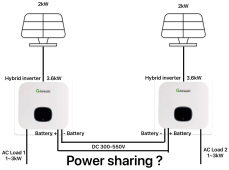You would need to figure out how to communicate between the inverter and battery. I intend to at some point to try to reverse engineer the communication between my min-tl-xh-us inverters and batteries but I have not gotten time to put any serious effort into it. I currently have two 11.4kW inverters and 9.9x6=59.4kW-hr of ARO batteries- if I add more battery it will be a cheaper non-Growatt option just for the challenge. I’ve been running off grid with one grid tied to the other.
What I have learned that may be useful to you: 1)if you put 400 vdc on either of the inverter battery inputs with no PV attached and no battery communication connected the inverter will wake up and use it. 2) it seems that the inverter battery voltage output may increase above a threshold near 500 vdc when the inverter does not need battery power and has PV available to charge with - I have not done any testing to see if a communication link must exist to the battery for this to occur, I’ve just observed it happening a couple of times when I was checking voltages, I am thinking of attaching something to watch continuously. 3) I’m absolutely certain that a person with patience, plenty of spare time and an understanding of how modbus and CAN communication works could develop a way to do it.
But, it’s a very good system and works well and I’m very happy with it so far and I could afford it - the only reason I will eventually do it is for the challenge.
FYI, SanTan has recently been selling the 9.9kW ARO for $6.5k, which is best price I’ve seen from a US supplier.






